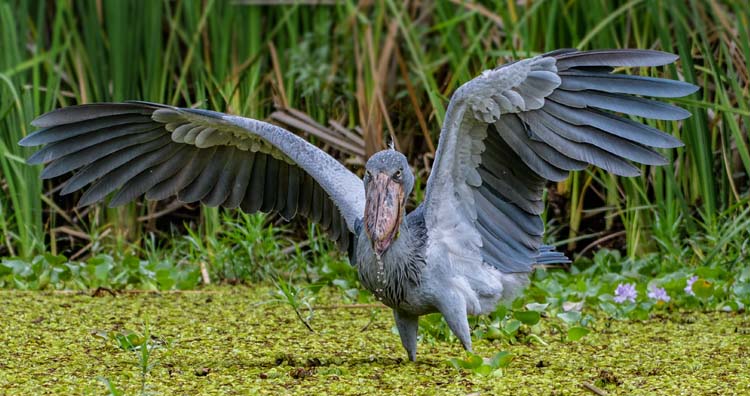

Download: Download the Medium 500 size of this photo (All sizes of. The Whale-headed Stork is classified as Vulnerable (VU), considered to be facing a high risk of extinction in the wild. License: Attribution Noncommercial Share Alike Some rights reserved by George Lamson. This article was originally published at. When birds of prey are flying over the swamps, dozens of smaller birds, like herons and ibises, are gathering around the giant Shoebills, which serve as a "stronghold of security", since they are detering the birds of prey just because of their size. Normally two eggs are laid and incubated. They build their nests, which are constructed as platforms consisting of swamp grass, on the ground. Only during the breeding season Shoebills can be found in pairs. Not very easy with a bill of that size! Shoebills have to stretch their wings to the back when snapping at their prey in order to keep the balance. They are grabbed with a quick push and swallowed up. Shoebills become active when fish or frogs come into view. They are standing in the shallow water almost motionless for hours, just moving the head or changing the leg, upon which they stand, from time to time. But it was found out at least that Shoebills are animals of a very restrained temper. These landscapes are not very easy of access and so there are just a few scientists, who have been able to observe Shoebills under natural conditions and study their behaviour and ecology. The large birds inhabit East African swamp regions, which are dominated by papyrus vegetation. The way Shoebills lead their lives is almost completely unknown too. Probably the "grey giant", which reaches a height of 1,5 metres, is related to storks, but this theory hasn't been confirmed finally yet.

It is still disputed how it should be classified. Although it is known to science since a long time and surely is among the most impressing and curious birds, there is not much knowledge about the Shoebill. Therefore the Shoebill has got the largest bill among all bird species. It is up to 20 cm long and almost of the same width. No surprise looking at its bill, which doesn't only look like a shoe but has got its dimensions too. "Abu Markub - father of the shoe" the Shoebill was called by arab explorers several centuries ago.


 0 kommentar(er)
0 kommentar(er)
